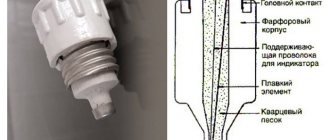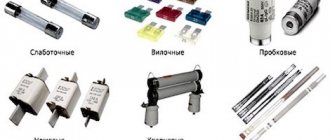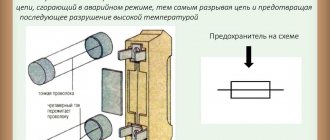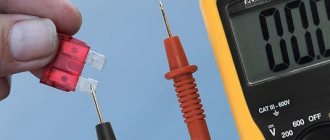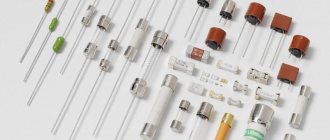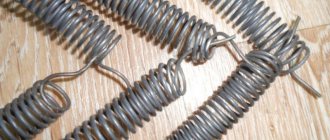Fuse
is an installation product designed to protect electrical appliances by cutting off the supply of electricity to them when the permissible current value is exceeded by melting the calibrated wire installed in the fuse.
To protect electrical wiring and expensive radio equipment from short circuits, current surges in the supply network and ensure the safe operation of electrical appliances, fuses are widely used. They are produced in different designs, standard sizes and for any protection currents.
The considered fuse repair technology, if all conditions are met, will ensure its protective function. But not everyone has experience working with a soldering iron and measuring wire diameter. And in any case, an industrial fuse will work more reliably.
Previously, apartment electrical wiring was also protected exclusively with the help of fuses installed in plugs. Currently, to protect electrical wiring, more reliable reusable short circuit protection devices are used - circuit breakers. In electrical appliances, nothing better protection against short circuits than a fuse has yet been invented. The use of fuses in cars is especially important, since they are the only reliable and cheap means of protection against short circuits.
Conventional graphic designation of a fuse
The conventional graphic designation of a fuse in the diagrams is similar to the designation of resistance, and differs only in that the line passes through the middle of the rectangle without breaking. Next to the symbol, the letter Pr is usually written. or F. Sometimes the diagrams simply write thermal fuse or fuse. After the letter, the protection current of the fuse is often indicated, for example F 1 A, means that the circuit has a fuse for a protection current of 1 ampere.
During operation, fuses fail and have to be replaced with new ones. It is believed that fuses cannot be repaired. But if you approach the repair process competently, then almost any fuse can be successfully repaired and reused. After all, the fuse body remains intact, and only a thin calibrated wire located inside the body burns out. If the burnt wire is replaced with the same one, the fuse will continue to serve.
Advantages and disadvantages
The advantages of fuses include:
- full guarantee of disconnection of the emergency section of the circuit;
- stability of technical protection characteristics;
- can be used for selectivity;
- performance;
- reliability;
- simplicity of design.
Main disadvantages:
- in three-phase networks, phase imbalance is possible;
- probability of prolonged arc burning;
- influence of the environment (temperature) on the characteristics of fuse links;
- difficulty in setting up selective protection;
- the need to replace the insert after each protection operation.
How the fuse works in the video
When an electric current passes less than the maximum permissible, the calibrated wire connecting the fuse contacts heats up to a temperature of about 70˚C. If the current exceeds the fuse rating, the wire begins to heat up more strongly and when the melting temperature of the metal from which it is made is reached, it melts, the electrical circuit breaks, and the flow of current stops.
That's why the fuse is called a fuse or fusible link. The video is presented in slow motion so that you can clearly see how the wire in the fuse burns out. In real conditions, the wire in the fuse burns out almost instantly.
Total views: 215924
The fuse protects against excess current in the circuit and the voltage of the supply network in which it is installed does not matter, it can be a 1.5 V battery, a 12 V or 24 V car battery, a 220 V AC network, a three-phase network 380 V.
That is, you can install the same fuse, for example, with a rating of 1 A, both in the fuse block of a car, and in a flashlight and in a 380 V switchboard. All types of fuses differ only in appearance and design, and work on the same principle - when exceeded of a given current in the circuit, the wire in the fuse melts due to heating.
There are two main reasons for fuse failure, due to surges in the supply voltage or a breakdown inside the radio equipment itself. Rarely, fuse failures also occur due to poor quality.
Many people think that the fuse cannot be repaired. But it is not so. In an emergency situation, when there is no spare at hand and, for example, because a car on the road or an amplifier refuses to work, and the musical accompaniment of a school ball or wedding is disrupted, and all the shops are already closed, there is no choice.
With the right approach, you can successfully restore a blown fuse for temporary use until it is replaced with a new one, preserving its protective functions. Often such problems are solved by simply closing the contacts of the fuse holder with any available wire, or even worse, simply inserting a nail or a piece of thick wire instead of the fuse. Such a decision can completely ruin everything and contribute to a fire.
Specifications
Fuse links are identified by two characteristics: rated voltage and rated current. In industrial equipment, these figures can reach tens of kilovolts and thousands of amperes.
Household appliances use fuse links, the rated voltage of the free contacts of which is:
- 110, 220 V – for direct currents;
- 220; 380 V – for alternating current.
At the contacts of common models, rated currents range from 10 to 2500 A, and at the ends of fuse links - from 2 to 2500 A.
Fuse Types
According to their purpose and design, fuses are of the following types:
- Plugs (mainly used to protect electrical wiring and devices in cars);
- With low-current inserts to protect electrical appliances with current consumption up to 6 amperes;
- Cork (installed in panels of residential buildings, designed for protection current up to 63 amperes);
- Knife type (used in industry to protect networks with current consumption up to 1250 amperes);
- Gas generating;
- Quartz.
The repair technology discussed in the article is intended for restoring fork fuses, with low-current inserts, plug and blade type fuses.
Tubular fuses
A fuse of a tubular design is a glass or ceramic tube, closed at the ends with metal caps, which are connected to each other by a wire of calibrated diameter running inside the tube. You can see the appearance of tubular fuses in the photograph.
The wire is spot welded to the caps or soldered with solder. In fuses designed for very high currents, the cavity inside the tube is often filled with quartz sand.
Automotive fuses
Fuses in cars rarely fail. Usually only in cases where the equipment fails. Most often when the headlight bulbs burn out. The fact is that when the filament of a light bulb breaks, a Voltaic arc is formed, the filament burns out and becomes shorter, the resistance sharply decreases and the current increases many times over.
It happens that a fuse in a car burns out when the windshield wipers jam. Less often during short circuits in electrical wiring. In the photo you see widely used automotive blade (fork) type fuses. Below each fuse is the current of its protection in amperes.
A blown fuse in a car should be replaced with a fuse of the same rating, but it can also be repaired by replacing the blown wire in the fuse with a copper wire of the appropriate diameter. The voltage of the car's on-board network does not matter. The main thing is the correspondence of the protection current. If it is difficult to determine the rating of a blown car fuse, then you can use color coding.
Color coding of automotive fuses
| Protection current, Ampere | 5,0 | 7,5 | 10,0 | 15,0 | 20,0 | 25,0 | 30,0 | 40,0 | 60,0 | 70,0 |
| Fuse body color | orange | brown | red | blue | yellow | transparent | green | violet | blue | black |
Design and use of disconnector holders
Rice. 3. Disconnector holder allows for safe replacement of fuse links
Traditionally, fuses are used in conjunction with a circuit breaker in series with a clear visual indication, i.e. switch Manually disconnecting the voltage allows for safe fuse replacement. But, at the same time, additional electrical wires, contacts and other connecting elements are added to the electrical circuit, where energy losses occur. Therefore, when we are talking about large powers, often the switch is not installed, but the fuse-links in the holder, which is under voltage, are replaced, naturally, in compliance with the necessary safety measures (Figure 3).
Disconnector holders allow you to safely replace fuse links and, if necessary, manually turn off the voltage. In this case, an additional switch is not required.
Structurally, disconnector holders are holders for fuse links, which allow them to be safely removed and inserted into contacts. Moreover, such devices, just like switches, provide a visual demonstration of the “off” mode. In the “off” position, the fuse-link can be removed from the disconnector holder; it is not energized.
Formula for calculating the diameter of the fuse wire based on the power of the electrical appliance
Power is often indicated on labels affixed to products. If the power consumption is indicated on the product, then the rated current of the fuse can be calculated using the formula below.
where
I
nom – rated fuse protection current, A;
P
max – maximum load power, W;
U
– supply voltage, V.
But it is much more convenient to use ready-made data from tables. Please note that the first table is used to select the fuse rating of products powered from a 220 V household power supply, and the second table is for products used in cars with an on-board voltage of 12 V.
Table for selecting the fuse rating depending on the power consumption of the electrical appliance at a supply voltage of 220 V
| Maximum power consumption of an electrical appliance, watt (BA) | 10 | 50 | 100 | 150 | 250 | 500 | 800 | 1000 | 1200 | 1600 | 2000 | 2500 | 3000 | 4000 | 6000 | 8000 | 10000 |
| Standard fuse rating, A | 0,1 | 0,25 | 0,5 | 1,0 | 2,0 | 3,0 | 4,0 | 5,0 | 6,0 | 8,0 | 10,0 | 12,0 | 15,0 | 20,0 | 30,0 | 40,0 | 50,0 |
Let's look at an example of how to choose a fuse. The TV stopped working after a thunderstorm. It has been determined that the fuse has blown. Its denomination is not known. On the back cover label it is written that the power consumption is 120 W, sometimes it is written as 120 VA. This is a designation of the same power, but according to the standards of different countries. According to the table, it turns out that for electrical appliances with a maximum power consumption of 120 W (the closest value is 150 W) there is a 1 A fuse.
The method for selecting a fuse to protect the on-board electrical wiring of a car is no different from the choice for 220 V household electrical wiring.
Table for selecting the fuse rating depending on the power consumption of the electrical appliance at a supply voltage of 12 V (vehicle on-board network)
| Electrical appliance power, watt (BA) | up to 50 | up to 75 | up to 100 | up to 150 | up to 200 | up to 250 | up to 300 | up to 400 | up to 600 | up to 700 |
| Standard fuse rating, A | 5,0 | 7,5 | 10,0 | 15,0 | 20,0 | 25,00 | 30,0 | 40,0 | 60,0 | 70,0 |
| Fuse body color | orange | brown | red | blue | yellow | transparent | green | violet | blue | black |
If after two replacements the fuses blow out each time, it means that the electrical appliance is damaged and requires repair. An attempt to install a fuse at a higher current can only cause further damage to the product, up to and including irreparability.
Fuse current calculator
If the tables do not contain data for your case, for example, the supply voltage of the product is 24 V or 110 V, then you can perform the calculation yourself using the online calculator below.
| Online calculator for determining fuse current | |
| Maximum load power, W: | |
| Supply voltage, V: | |
When calculating on a calculator you will get the exact current value. For reliable operation of the fuse, its rating must be at least 5% higher. For example, if a calculated current value of 1 A is obtained, then you need to take a fuse of the highest closest rating from the standard range, that is, 2 A.
Sometimes attempts to determine the fuse rating by reading the information do not work. There are no inscriptions on the electrical device; the markings on the fuse are unreadable. If you have an ammeter and experience working with it, then by removing the fuse and connecting the ammeter to the contacts of the block in which the fuse was installed, you can measure the current and thereby determine its rating.
But there is a pitfall here. If the fuse fails due to a malfunction of an electrical device, then the current may be much greater than it should be, in addition, the measuring device may also be damaged.
Product Overview
As an example, let's look at fuses and disconnector holders produced by three companies that are deservedly popular on the Russian market: Siemens, Eaton and ETI.
As befits one of the world's leading electrical companies, Siemens offers the widest range of fuses. The model range opens with the simplest and cheapest cylindrical fuse links of the gG and aM categories. Their rated current is, depending on the model, 0.5...100 A, and the voltage is 400...500 V. The parameters of these fuse links are standardized only for alternating current. Available in sizes 8x32, 10x38, 14x51 and 22x58 mm.
Rice. 4. Cylindrical fuse links
For cylindrical fuse links (Figure 4), Siemens produces holders for DIN rails. Models available with 1P, 1P+N, 2P, 3P and 3P+N poles. They can be either with or without a trip indicator (except for 3P+N poles). The modular width, depending on the model, is 1…8 MW.
The main advantage of these cylindrical fuse links, in addition to their low cost, is the completely closed design of the holder. Thanks to this design, the possibility of involuntary touching of current-carrying elements is practically eliminated. The disadvantages are the relatively low current and voltage ratings. This is due to the difficulties of removing heat from the housing and extinguishing the arc in the simplest fuses.
For voltages up to 690 V AC and current values up to 1250 A, fuse-links of the LV HRC series are designed. The bases for them are also mounted on a DIN rail, but the fusible links are held in the base by spring contacts. The fuse design itself is open, which ensures effective air cooling of the case. The LV HRC series inserts are equipped with a built-in operation indicator.
Inserts of categories gG and aM are offered. The modular width, depending on the model, is 21…71.2 mm.
The parameters of fuse-links of the LV HRC series of category gG are standardized for both alternating and direct current. For direct current, the rated voltage does not exceed 440 V.
The SITOR series of fuse links and fuses are designed specifically to protect semiconductor elements. Its main feature is the normalization of the I2t value. This series, in particular, includes cylindrical inserts of category aR. They are offered in sizes 10x38, 14x51, 22x58 mm without striker and sizes 14x51 and 22x58 mm with striker. The rated current, depending on the model, is 1...100 A, and the rated voltage reaches 600...690 V AC or 700 V DC. As we can see, the rated voltage for DC in the SITOR series is higher than the rated rms voltage for AC, unlike the LV HRC series. This is due to the optimization of fuse links for the protection of semiconductor devices.
SITOR series – fuse-links with blade contacts (Figure 5), designed for installation in bases of the LV HRC series or in disconnectors. These models belong to the categories aR and gR, their rated voltage, depending on the model, can reach 690 V, and the current - 1000 A (parameters are standardized only for alternating current). Also available are independent fuses in the form of a single block that do not need a base, and fuses that can be used both as independent devices (they have the ability to screw the wires directly to the contacts) and installed on the base of the LV HRC series.
Rice. 5. Siemens fuse link with blade contacts | Rice. 6. Example of D0 type fuse link |
In addition to fuse links, the SITOR series includes bases for cylindrical fuse links, as well as two versions of disconnector holders for DIN rails. One of them is available in modifications 1P, 2P and 3P for inserts without a striker. The other is available only in the 1P modification and is designed for inserts with a striker. The rated voltage of both disconnect holders is 690 V AC.
Eaton has a more modest range of fuse links. ZC cylindrical inserts are available in sizes 10×38, 14×51, 22×58 mm and Z-NH inserts with blade contacts. For ZC inserts, the rated current, depending on the model, is 1...100 A, the rated voltage is 690 V AC. For Z-NH, the rated current is 10...630 A. Both series of fuse-links belong to the gG category.
But Eaton presents several models of disconnector holders on the Russian market, both for cylindrical fuse-links and for inserts with blade contacts. Some models are equipped with an electronic monitoring system for fuse links with LED indication. Also, one of the models provides a relay alarm in the event of a fuse tripping.
To increase the convenience and safety of replacing fuse links in disconnector holders, Eaton produces special cartridges with Z-SLS type D0 fuse links with rated voltages up to 400 V and currents up to 63 A. It should be noted that D0 (Figure 6) is the most common a series of fuse links for plug-type fuses, that is, fuses that use a holder with a threaded connection. Cartridges make it possible to realize such advantages of the D0 type as small sizes and low power losses, but in a new format, different from the well-known “plugs”. A special model of disconnector holder is designed for them. There is also a low-voltage version Z-SLS for voltages 24...60 V. Z-SLS fuse-links and holder-disconnectors for them are very easy to maintain, which allows them to be installed at end consumers and even in the residential sector. Additionally, maintenance is simplified by the presence of a modification of such a disconnector holder with electronic monitoring.
A large assortment of small-sized fuse-links of type D0, category gG (gL), is supplied to the Russian market by ETI. The rated voltage of these components is 400 V AC (250 V DC), the rated current, depending on the model, is 2...100 A. At the same time, the company offers threaded holders for them with a classic design in sizes E14, E18 and M30x2. The advantages of “plugs” are still reliable fastening, safety of use (you can change the fuse-link in a live circuit without touching the current-carrying components) and ease of maintenance. Modern polymer materials eliminate “sticking” of the threaded connection and allow for a convenient, ergonomic design.
D0 fuse links can also be installed in VLD01 disconnector holders, which are also produced by ETI. These disconnector holders are available in 1P, 1P+N, 2P, 3P and 3P+N versions. A special feature of VLD01 is the ability to seal the disconnector both in the on and off position. There is an indication that the fuse has tripped. The design of the VLD01 terminals allows for simultaneous clamping of the conductor and the terminal, which reduces the number of installation products in the system.
ETI also produces cylindrical fuse links in glass and ceramic cases. Of particular interest is the CH series - inserts in ceramic cases of standard sizes 14x51 and 22x58 mm. Rated voltage - 400, 500 or 690 V. Rated current - up to 100 A. Models in categories gG and aM are offered. There are options for 14x51 mm inserts with a striker (CH/P series). For cylindrical fuses there is a series of VLC disconnector holders.
This company's product range also includes fusible inserts with knife-type contacts - the NV-NH series. They are distinguished by a very high rated current. Depending on the model, it ranges from 2...1600 A. Rated voltage - 400, 500, 690 or 1000 V. There is a built-in operation indication. Fuse links are available in categories gG, aM and gT. The presence of high power fuse links in the ETI range, specifically designed to protect transformers, is a great advantage over other manufacturers. The high speed of ETI fuses allows you to switch off the load in less than a quarter of the current period.
For fuse links with knife type contacts, ETI produces PK and PK1 bases. The rated base voltage is 690 VAC.
ETI's range also includes ultra-fast fuses (Figure 7), designed to protect semiconductor equipment. These fuses operate within 10 ms at a current level of 5...6 times the rated current. In this case, it is possible to prevent such an unpleasant phenomenon as the explosion of IGBT transistors. For comparison, conventional fuses operate in the same time only when the current is 10...30 times higher than the rated value, which increases the likelihood of failure of semiconductor elements. By the way, such high performance as that of the Ultra-Quick series can only be achieved with a fuse - thermal automatic circuit breakers operate more slowly. ETI ultra-fast fuses use a silver fuse element to ensure stable timing characteristics.
Rice. 7. Features of ETI Ultra Fast Fuses
ETI's ultra-fast fuses are part of the Ultra-Quick series. They are represented by the categories aR, gR, gS. The rated current, depending on the fuse model, can reach 1400 A. Compared to other manufacturers, ETI ultra-fast fuses have two important features. Firstly, the product range covers all main types of fuse links: D0, D, C, BS, NV/NH. Tubular fuse links, blade-type fuses, and fuses for installation directly on the busbar are available. NV/NH Gs fuse links are also available, specifically designed to protect frequency converters and soft starters. Secondly, lower price. On average, ETI ultra-fast fuses are 10% cheaper than similar products produced by companies such as Legrand or ABB.
Why is price so important for ultra-fast fuses? Their high cost is associated both with the use of silver and with more complex manufacturing technology. Fierce competition in the electrical equipment market has led to a number of manufacturers of such equipment abandoning the use of fuses and leaving only electronic protection. The main goal is to reduce the price of the product. However, the parameters of the electronic protection system change over time, and its reliability is not as high as that of a fuse link. As a result, electric cars wear out faster. Therefore, the best option is a combination of fuse and electronic protection. The lower price of the fuse allows you to price the product competitively.
For Ultra Quick series fuse links, US series holders and signal contacts are available. Holders in this series can withstand voltages up to 1000 V AC.
Calculation of fuse wire diameter
To repair the fuse, it is necessary to replace the burnt wire. In the production of fuses in factories, depending on the current value and speed, calibrated silver, copper, aluminum, nickel, tin, lead and wires made of other metals are used.
For making a fuse at home, only red copper of calibrated diameter is available. All electrical wires are made of copper, and the more elastic the wire, the thinner the conductors and the greater the number of them. Therefore, all the technology proposed below is focused on the use of copper wire.
When choosing a fuse for equipment, developers use a simple law. The fuse current must be greater than the maximum consumed by the product. For example, if the maximum current consumption of the amplifier is 5 amperes, then the fuse is selected at 10 amperes. The first thing you need to do is find its marking on the fuse body, from which you can find out what current it is designed for. Often the current value is written on the product body, next to the location where the fuse is installed. Then, from the table below, determine what diameter wire is needed.
Regulations
Safety is a critical factor both in production processes and in people's daily lives. Therefore, fuses must necessarily meet the stringent requirements of existing safety standards. Any official manufacturer indicates what safety standards its products meet.
Different countries have their own regulatory bodies and regulations. For the domestic market, IEC standards are primarily of interest. In particular:
- GOST R IEC 60127-1-2005 Miniature fuses. Part 1: Terminology for fuses and general requirements for miniature fuse links;
- GOST IEC 60127-2-2013 Miniature fuses. Part 2. Tubular fuse links;
- GOST IEC 60127-3-2013 Miniature fuses. Part 3. Subminiature fusible links;
- GOST IEC 60127-4-2011 Miniature fuses. Part 4. Universal modular fuse-links for volumetric and surface mounting;
- GOST 30801.5-2012 (IEC 60127-5:1989) Miniature fuses. Guide to Certification of Miniature Fuse Links;
- GOST IEC 60127-6-2013 Miniature fuses. Part 6. Fuse holders with miniature fuse link.
According to GOST R IEC 60127-1-2005, a fuse is a device that, by melting one or more of its parts having a certain design and dimensions, opens the circuit in which it is connected, interrupting the current if it exceeds a specified value for a certain time. The same standard presents the characteristics of fuses and general requirements for them.
Tables for selecting wire diameter depending on the fuse protection current
For repairing fuses with protection current from 0.25 to 50 amperes
| Fuse protection current, Ampere | 0.25 | 0.5 | 1.0 | 2.0 | 3.0 | 5.0 | 7.0 | 10.0 | 15.0 | 20.0 | 25.0 | 30.0 | 35.0 | 40.0 | 45.0 | 50.0 | |
| Wire diameter, mm | Copper | 0.02 | 0.03 | 0.05 | 0.09 | 0.11 | 0.16 | 0.20 | 0.25 | 0.33 | 0.40 | 0.46 | 0.52 | 0.58 | 0.63 | 0.68 | 0.73 |
| Aluminum | — | — | 0.07 | 0.10 | 0.14 | 0.19 | 0.25 | 0.30 | 0.40 | 0.48 | 0.56 | 0.64 | 0.70 | 0.77 | 0.83 | 0.89 | |
| Steel | — | — | 0.32 | 0.20 | 0.25 | 0.35 | 0.45 | 0.55 | 0.72 | 0.87 | 1.00 | 1.15 | 1.26 | 1.38 | 1.50 | 1.60 | |
| Tin | — | — | 0.18 | 0.28 | 0.38 | 0.53 | 0.66 | 0.85 | 1.02 | 1.33 | 1.56 | 1.77 | 1.95 | 2.14 | 2.30 | 2.45 | |
For repairing fuses with protection currents from 60 to 300 Amps
| Fuse protection current, Ampere | 60 | 70 | 80 | 90 | 100 | 120 | 160 | 180 | 200 | 225 | 250 | 275 | 300 | |
| Wire diameter, mm | Copper | 0.83 | 0.91 | 1.00 | 1.08 | 1.16 | 1.31 | 1.59 | 1.72 | 1.84 | 1.99 | 2.14 | 2.28 | 2.41 |
| Aluminum | 1.00 | 1.10 | 1.22 | 1.32 | 1.42 | 1.60 | 1.94 | 2.10 | 2.25 | 2.45 | 2.60 | 2.80 | 2.95 | |
| Steel | 1.80 | 2.00 | 2.20 | 2.38 | 2.55 | 2.85 | 3.20 | 3.70 | 4.05 | 4.40 | 4.70 | 5.0 | 5.30 | |
| Tin | 2.80 | 3.10 | 3.40 | 3.65 | 3.90 | 4.45 | 4.90 | 5.80 | 6.20 | 6.75 | 7.25 | 7.70 | 8.20 | |
Littelfuse explosion-proof fuses
In addition to general purpose fuses, Littelfuse also offers specialized series, such as explosion-proof fuses 242, PICO 259, PICO 259-UL913, PICO 304 and PICO 305 (Figure 17, Table 4).
Rice. 17. Littelfuse explosion-proof fuse series
Table 4. Characteristics of Littelfuse explosion-proof fuses
| Name | Current rating, A | Voltage rating, V | Breaking capacity, A | Operating temperature, °C |
| 242 | 0,05…0,25 | – | 4000 | -40…125 |
| PICO 259 | 0,062…5 | – | 50 (125 V AC), 300 (125 V DC) | -55…125 |
| PICO 259-UL913 | 0,062…5 | – | 50 (125 V AC), 300 (125 V DC) | Depends on current rating |
| PICO 304 | 0,05…0,75 | – | 1500 | -40…85 |
| PICO 305 | 0,05…0,75 | – | 1500 | Depends on current rating |
In explosive environments, an indispensable condition for ensuring safety is the use of electrical devices that prevent sparking. Examples include the chemical, oil and gas, mining, food and medical industries. Requirements for such applications are described in GOST 31610.11-2014 (IEC 60079-11:2011) “Explosive atmospheres. Part 11. Equipment with type of explosion protection “Intrinsically safe electrical circuit “i” (as amended).” To provide guaranteed protection against sparking, fuses of the 242, PICO 259, PICO 259-UL913, PICO 304 and PICO 305 series have an additional protective coating (Figure 18) [2].
Rice. 18. Design features of intrinsically safe fuses
Series 242 fuses have a fairly narrow range of current ratings of 0.05...0.25 A, but have a record high breaking capacity of 4 kA. Representatives of the series have two versions - for through-hole mounting and for installation in a holder.
PICO 259 fuses are used to protect low voltage circuits (up to 190V) and have a wide range of current ratings from 0.062...5A. These fuses are designed for through-hole mounting.
The PICO 259-UL913 series is similar to the PICO 259 series, but meets the requirements of UL 913.
PICO 304 series fuses, unlike other explosion-proof series, are designed for surface mounting. They have a relatively narrow range of current ratings of 0.05...0.75 A, but are characterized by a high breaking capacity of 1.5 kA and a voltage rating of 375 V.
PICO 305 fuses have the same characteristics as the PICO 304 series, but are designed for through-hole mounting.
Formula for calculating the diameter of copper wire for a fuse
To determine more accurate values for the diameter of a copper wire to repair a fuse, or if a fuse is required for a protection current whose value is not in the table, you can use the formula below.
where
I
pr – fuse protection current, A;
d
– diameter of copper wire, mm.
| Online calculator for calculating wire diameter depending on current | |
| Enter the maximum current value, A: | |
General calculation rules
In order to make the correct calculation of fuse links, it is necessary to take into account the rated voltage.
This value should be such that the fuse switches off the electrical circuit. The main indicator is the minimum voltage provided for the base and fuse-link. Another important indicator that should be taken into account in the calculations is the shutdown voltage. This parameter is the instantaneous value of the voltage that appears after the fuse or fuse link itself has tripped. As a rule, the maximum value of this voltage is taken into account.
In addition, the melting current must be taken into account, on which the diameter of the wire installed inside depends. When calculating a fuse link, for each metal this indicator has its own value and is selected using a table or calculator. The material and size of the inserts must provide the required protective characteristics. The length of the insert cannot be too long, as this will affect arc extinction and overall temperature characteristics.
The rated load power is usually indicated on the product label. In accordance with this parameter, the rated fuse current is calculated using the formula: Inom = Pmax/U, in which Inom is the rated protection current, Pmax is the maximum load power, and U is the supply voltage.
How to measure wire diameter
The diameter of a thin wire is best measured with a micrometer. If you don’t have a micrometer at hand to measure the diameter of the wire, you can use an ordinary ruler.
You need to wind 10-20 turns per turn of wire on a ruler, divide the number of closed millimeters by the number of wound turns. Get the diameter. For example, I wound 10 turns of wire and they covered 6.5 mm. Divide 6.5 by 10. The diameter of the wire is equal to 0.65 mm. 0.05 mm is occupied by insulation. Therefore, the actual diameter is 0.6 mm.
Such a wire is suitable for making a 30 A fuse. The wire was wound thick for greater clarity. The more turns you wind on the ruler, the more accurate the measurement result will be. You need to wind at least one centimeter. If you have a short length of wire, then wind it around any rod, for example, a screwdriver, toothpick or pencil, and measure the width of the winding with a ruler.
| Online calculator for calculating wire diameter | |
| Winding width on the ruler, mm: | |
| Number of turns: | |
You can process the measurement results using an online calculator. To determine the diameter of the wire, just enter the winding width, the number of turns in the windows and click “Calculate wire diameter”.
How to choose power wiring
The power cable must be compatible with the system it powers. If the cable is not thick enough, there will be large losses in it, that is, “sagging,” as this phenomenon is now commonly called. It is due to the fact that the cable has, although vanishingly small, resistance.
It is really very small, about 0.3 - 0.8 Ohm per km of cable length. But it still exists, and at high currents on the line, losses can be noticeable.
Selection of cable cross-section
In order to select a cable of the required cross-section, you do not need to calculate anything. You can, of course, set the current consumption, the permissible drawdown, for example, the current in the system is 100A and the drawdown is no more than 0.5 V, and calculate the required cable cross-section, taking into account the length of the line. This is not necessary. There is an old rule of thumb for selecting the cross-section of a power cable, which for simplicity is called “five amperes per square”:
It is based on the fact that the length of the line from the source to consumers (to amplifiers) does not exceed 5 m. This is 99% of all cases. What does this rule mean? This is the standard for current density. With a current density of five amperes per square millimeter, losses on a cable up to 5 meters long will be no more than 0.5V. Precisely no more than 0.5, this is important at maximum, and not operating, current.
How to use this rule? Take the amplifier and see what its fuse rating is. If there are several, consider the total denomination. If you have several amplifiers and you will power them with one cable, add up the ratings of their preamps. We take the result obtained as the maximum current consumption. The real worker will be noticeably smaller. We divide the maximum current by 5 and get the required cable cross-section (“5A per 1 sq mm).
Next, take the next larger standard cable cross-section. Example. We have an Oris TA-150.4 amplifier. It has a 100A fuse installed on it. Typically, the manufacturer provides a margin of 10-20% when selecting a fuse. Accepts maximum current for 100A. Divide 100 by 5 to get 20 squares. To power such an amplifier you will need a cable with a cross-section of at least 20 sq mm. We select the following standard cable cross-section - 25 sq mm. All. To power the Oris TA-150 amplifier.
4, a cable with a cross-section of 25 square millimeters is necessary and sufficient. You can use a cable that is one section larger, and it won’t be any worse. Will it be better? Practice shows that if you take a cable two or more sizes larger, it will definitely not be better. Losses on the cable are already approaching zero.
Use the “five amperes per square” rule, select the required cable cross-section or one size larger. Buying a thicker cable will not be advisable.
The drawdown lives not only on the cable. And, for example, also on the fuse.
Fuse selection
A fuse on the power line must be required and must be installed not far from the power source. In an emergency, it must protect the power source from short circuit. It doesn’t matter what happened, the cable frayed and shorted to ground, or the amplifier burned out and somehow shorted it. The fuse must blow to prevent the wiring from catching fire.
The operating principle of a fuse is simple and is based on Ohm's law for a complete circuit.
Where Un is the voltage drop across the system elements: at the wiring, at the limiter, at the amplifier itself, etc.
These are all dips of their kind, but we don’t call the voltage drop across the amplifier that way. The magnitude of the voltage drop depends directly on the resistance of the system element and is always many times less than the voltage drop on the main link - the amplifier. So far so good, the losses on the cable and fuse are not significant, everything works. Now let’s imagine that some emergency has occurred. The wiring has shorted.
Of all the elements of the system connected to the power source (battery), only the power cable and fuse remain (the amplifier has fallen out of the system). And all its energy will be dissipated precisely on the cable and at the limit. Which one will burn out first, the wire or the front? For a fuse to blow, the drawdown on it must be much greater. Then it will work stably. Therefore, the fuse must be selected strictly according to the cable.
Not by current consumption, but specifically by cable cross-section.
The fuse rating is also selected according to the “five amperes per square” rule. Only in the opposite direction. Let's say you need to select a fuse for a cable with a cross-section of 25 squares, which powers the same Oris TA-150.4 amplifier. Multiply 25 by 5, we get the required rating of 125A. The next larger one is rated 150A.
If the power wiring is selected according to the described rule, the system operates stably, with a good margin, and in the event of a short circuit, the fuse operates clearly. Cable and fuse losses are very small. There is no need to remove the fuse. This is sometimes done in competitions to reduce drawdown. But we don’t need this at all for everyday use.
DIY fuse repair
Tube fuse repair
The first one is the simplest. The wire is stripped to a shine and wound several turns onto each cup, then the fuse is inserted into the holder. This method is unreliable and can only be used as a temporary measure. Due to its simplicity, it allows you to quickly check the serviceability of an electrical appliance. If the wire melts when turned on, then the problem is not the fuse, and more qualified repairs are required.
The second method is somewhat more complicated. But it also does not require soldering. You need to warm up the cups one by one with a lighter or on a gas stove and, holding them through the cloth with your hands, remove them from the glass tube. You can also heat it with a soldering iron. To ensure good contact, the inside of the cup must be thoroughly cleaned of any glue residue.
Pass the wire stripped of insulation through the tube diagonally, bend its ends along the tube and put the cups in place. The fuse has been repaired.
The third method is essentially the same as the first two. But a repaired fuse is practically no different from a new one. The repair is carried out as follows.
When making a fuse, factory calibrated wire is threaded through the holes in the ends of the cups and fixed with solder. In order to insert a new wire, you need to heat the ends of the cups with a soldering iron and use a toothpick or a sharpened wooden stick to free the holes in the ends of the cups from solder. Next, perform the factory operation described above.
There are holes in cups of very small diameter and it is difficult to clean them from solder. Then, if technically possible, it is easier to drill holes with a drill with a diameter of 1-2 mm or widen them with a faceted awl
The proposed technology for repairing fuses and fuse links can be successfully used to restore almost any type of fuses.
Blade type car fuse repair
The technology for repairing a car fuse is no different from the technology for repairing a tubular fuse; it is even simpler, since there is no need to disassemble it.
First, you need to use sandpaper or a file to clean the fuse knives at its base with a strip of a few millimeters and tin these places with solder.
When tinning, I encountered the fact that when using alcohol-rosin flux, the solder did not want to spread over the surface of the knives. I had to use FIM flux, intended for soldering copper, silver, constantan, platinum and ferrous metals. The basis of the flux is phosphoric acid. I always use it for soldering if rosin is not suitable. Residues of FIM flux are removed by washing with water.
The fuse was designed for a protection current of 10 A, therefore, in accordance with the table above, a wire ⌀0.25 mm was taken for repair. The wire was shaped into a loop, as shown in the photo, and its ends were tinned with solder.
After all the preparatory work, all that remains is to insert the wire loop inside the fuse housing and solder the ends to the legs.
Spread solder can be cut off with a knife, removed with sandpaper, or filed off with a file.
The car fuse has been repaired and can now be reused to protect circuits in the car's electrical wiring. If, after installing the repaired fuse, it blows again, then you need to look for a fault in the vehicle’s electrical equipment.
conclusions
A comparison of the range of ]Siemens[/anchor], Eaton and ETI presented on the Russian market shows that all three companies produce the most common types of fuse links (cylindrical, with blade contacts) and bases for them. Siemens has a unique series of fuse links and holders, SITOR, optimized for the protection of semiconductor elements. The other two companies have no analogues to this series.
Of interest are the Eaton DIN-rail disconnector holders, which are made as convenient as possible to use. D0 fuse links in cartridges and a clear LED trip indication system simplify the maintenance of fuses and allow them to be recommended for installation by end consumers.
ETI, unlike other companies mentioned in the review, does not abandon the production of time-tested classics - holders with threaded fastening ("plugs"), making them more convenient through the use of modern materials. Another feature of ETI products is the presence of heavy-duty blade fuse links designed to protect transformers. For cylindrical fuse links, ETI offers disconnector holders with a simple but convenient design. Of great interest is the Ultra Quick line of ultra-fast fuses, which have high technical characteristics at a low price. Thanks to the silver fusible element, high stability of time parameters is ensured.
We choose the diameter of the fuse wire - we analyze all the subtleties of the issue
A homemade copper wire fuse can be a great temporary way to replace a blown fuse. But if you decide to do this, then it is extremely important to choose the right cross-section of the very conductor that you will use. Why is this important, what are the reasons for blown fuses and ways to temporarily eliminate this inconvenience we will consider in our article.
Causes of blown fuses
Let's start with the most important thing - the reasons for blown fuses. After all, nothing just happens, and before installing a bug, you need to determine the reasons for the fuse failure.
There may be several of them:
